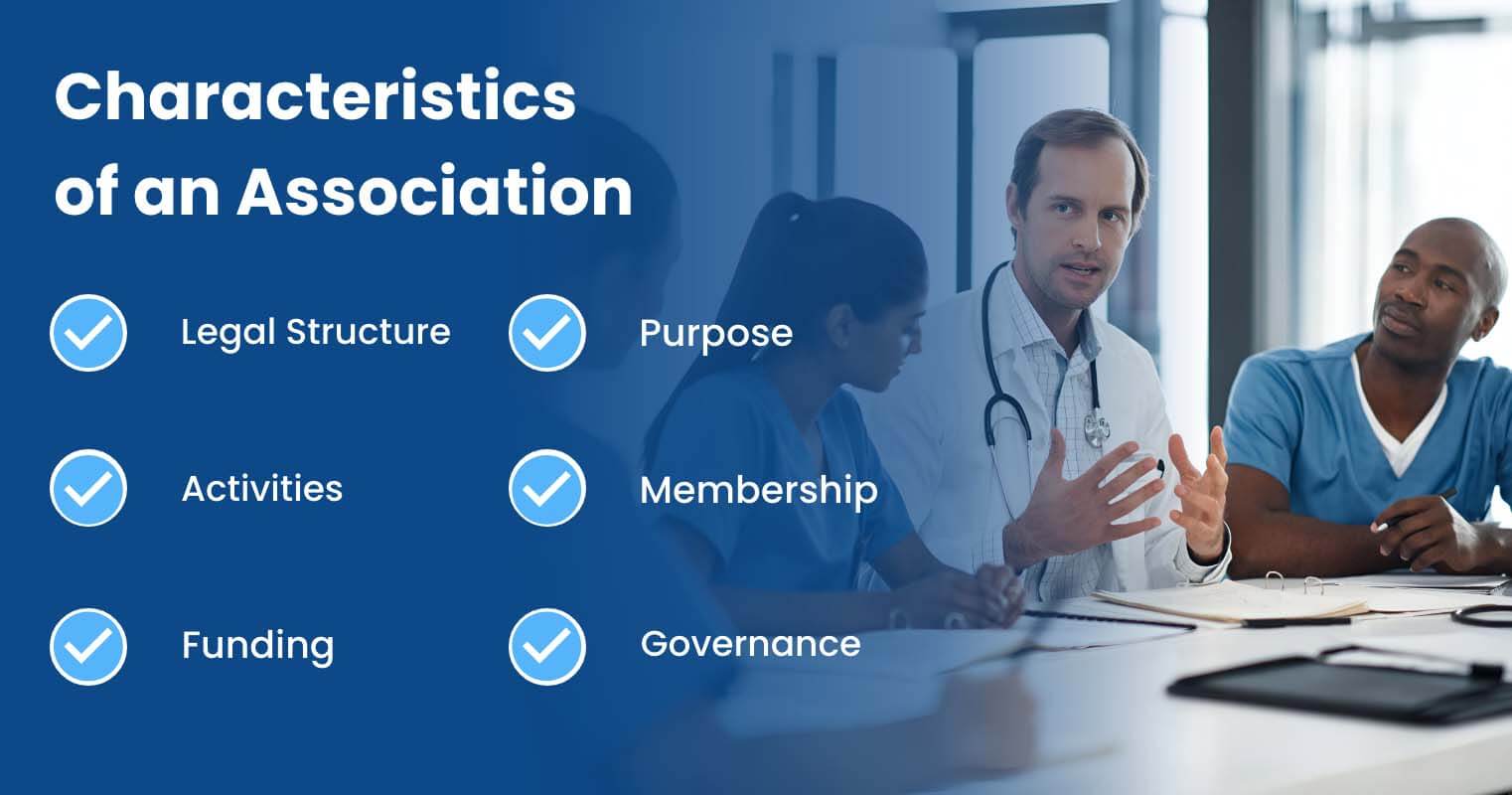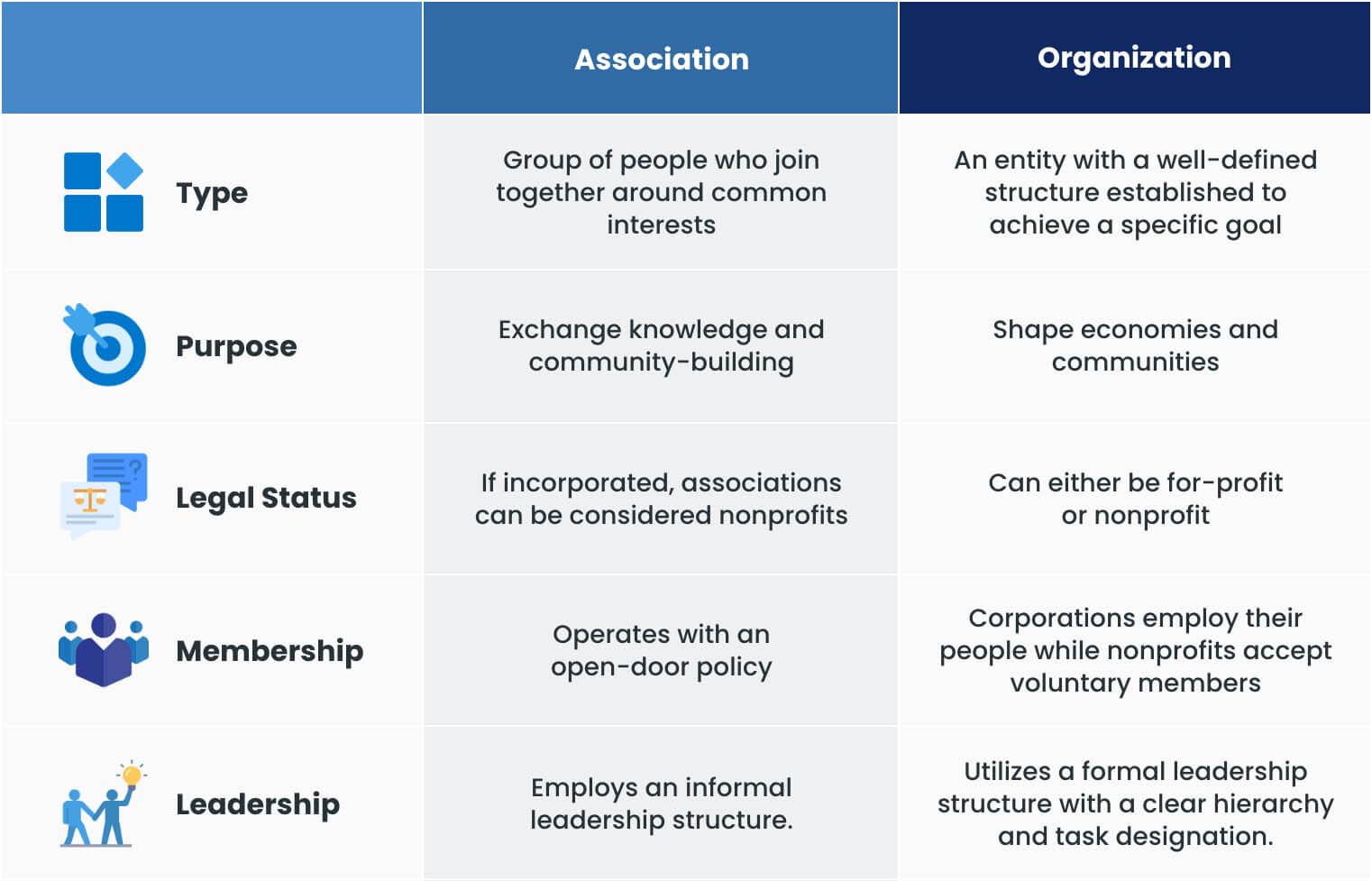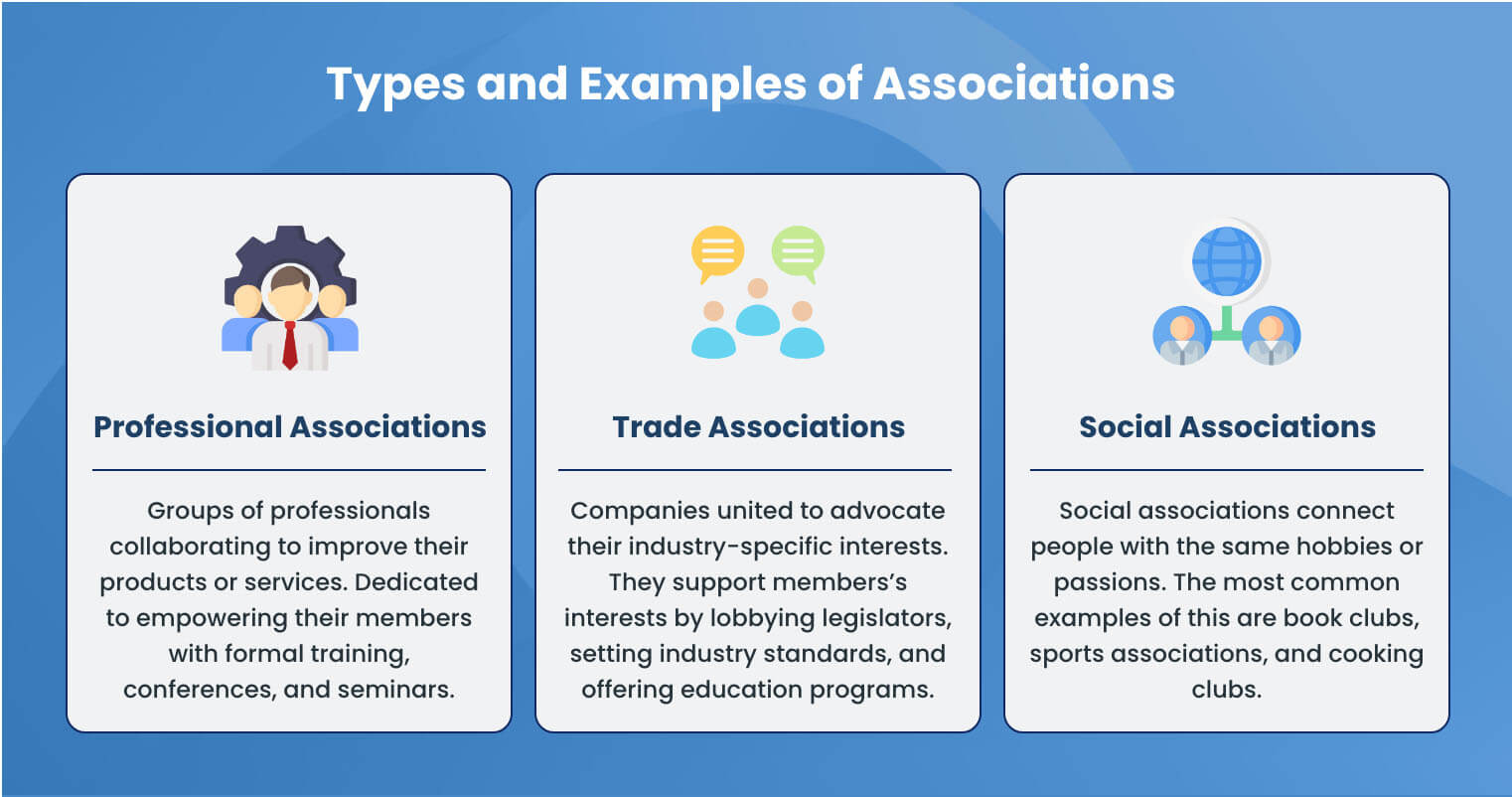Associations and organizations may seem similar at first glance, but they are two distinct entities with different purposes, governance styles, and structures. Understanding their nuances is crucial in choosing whether to start an association or organization to avoid making a wrong decision.
Get a head start by using this guide to delve into associations and organizations! Breaking down their characteristics, discover how much they differ and in what aspects they are similar. At the end, review a detailed table summary of the comparison.
What is an organization?
An organization is a legal entity that represents an assembly of people who collaborate to reach a long-term goal. It comes in multiple sizes and operates in various forms such as international corporations, NGOs, or local government agencies. Each has its unique goals, but they generally operate to earn profit, promote innovation, or champion a social cause.
Having a governance framework is a key identifier of an organization. It enables organizations to develop a formal structure they can follow when making decisions, dividing responsibilities, and running operations. Organization can be classified into main types: for-profit and nonprofit. Nonprofits are charities or foundations that prioritize social causes and public benefit over financial gains. On the other hand, for-profits or corporations, are businesses operating to earn profit.
Characteristics of an Organization

Legal Structure
The operational foundation of an organization lies in its legal structure. It provides groundwork on how owners must execute business activities properly to achieve their goals. Implementation of legal structure is a requirement across organizations, however, its applicability depends on its purpose, ownership, and goals.
For corporations, the primary legal structures are as follows:
- Sole Proprietorship involves a single owner who is responsible for all aspects of the business. Its duties include managing daily operations, tax obligations, and finances.
- Partnership has two or more owners involved in managing the business. These owners mutually agreed to share profits and bear losses.
- Corporation permits owners to establish a separate entity from them, providing limited personal liability. Organizations with this legal structure operate on a larger scale, requiring more resources to sustain them.
- Limited Liability Company (LLC) is a hybrid of partnerships and corporations. It adopts how corporations protect their owners from liabilities and incur lower tax dues like that of partnerships.
For nonprofits, the Internal Revenue Service (IRS) implements a framework organizations must adhere to qualify for tax exemption. According to its guidelines, nonprofits should submit organizational documents, such as Articles of Incorporation and bylaws, to prove their tax-exempt purpose and 501(c)(3) eligibility.
Purpose
Organizations disrupt their industries by bringing transformative services and innovative products. They are essential forces in society that shape economies and communities. For example, corporations make markets evolve by creating jobs, developing technologies, and providing goods and services. In terms of social causes, nonprofits champion accessibility and fairness for marginalized sectors.
Activities
A well-functioning organization has systems to keep operations smooth for every department. To ensure long-term stability, they must maintain activities in the following aspects:
- Operations: These are activities related to supporting the organization’s daily operations. It involves departments such as sales, marketing, HR, customer service, and IT.
- Finance: Financial activities refer to how executives manage an organization’s funds and strategically allocate them to projects. It involves fiduciary tasks such as debt management, dividend distribution to shareholders, and cash flow analysis to ensure the organization’s long-term financial health.
Membership and Stakeholders
Corporations have internal stakeholders—individuals collaborating to create a cohesive and dynamic working environment to drive the organization forward. These include employees, managers, the board of directors, and shareholders.
Nonprofits, on the other hand, rely on their members. These are individuals who voluntarily support the organization’s mission. To help promote social causes, members engage in volunteer work or give donations.
Funding
Corporations earn profits through their products and services. As market opportunities widen, they also explore other income-generating strategies, such as investing in stocks, bonds, and venture capital. Meanwhile, nonprofits involve their communities when raising funds. They collect donations, apply for funding grants, organize fundraising events, and utilize membership fees. Additionally, there are private foundations that receive lump-sum investment funds to ensure their long-term sustainability.
Governance
Governance is a crucial factor in the success of an organization, and the board of directors is responsible for ensuring it is enforced properly. As the primary governing body, the board leads operations, audits controls, and executes fiduciary duties. Their core responsibilities include developing strategic direction, financial oversight, leadership, compliance, and risk management.
To effectively perform their duties, the board of directors can leverage the power of board portal software to amplify their governance. This technology modernizes governance, enabling decision-makers to discuss matters and review documents through a screen. This empowers the board to collaborate and make informed decisions more efficiently.
Supporting the board in their leadership, organizations often establish sub-groups. These groups focus on different aspects, including human resources, accounting, marketing, and operations. Nonprofits may also have committees dedicated to executive affairs, fundraising, and volunteer management.
What is an association?
Associations are informal groups of individuals united by shared interests such as profession, business, and hobbies. They provide a platform for members to connect, share knowledge, and collaborate on mutual pursuits. Unlike organizations, associations often operate with looser frameworks, primarily using their shared goals to direct their activities.
Characteristics of an Association

Legal Structure
Similar to organizations, associations also have legal structures: incorporated and unincorporated.
- Incorporated association is a legally registered entity separate entity from its members. Like nonprofits, it can make profits, own properties, and sign partnerships to advance its goals. An example of this is professional associations. In the United States, incorporated associations may qualify for tax-exempt status, such as 501(c)(3) and 501(c)(6), if they meet specific requirements.
- Unincorporated association has smaller operations and is not a separate legal entity from its members. It has no formal structure and doesn’t require its members to adhere to legal frameworks. Examples of this are book clubs, homeowner associations, and religion sub-groups.
Purpose
At its core, the purpose of associations is to bring people with common interests together. It builds a community that nurtures connection, facilitates knowledge exchange, and cultivates mutual support among members.
Activities
Activities enhance engagement in associations, leading to increased member interest and participation. Participating in these activities allows members to deepen their knowledge of their chosen field. Here are some common activities associations conduct for their members:
- Networking: Bonded by common interests, associations hold networking events where members can connect, discuss concepts, and build meaningful relationships.
- Lobbying: Associations use their influence to lobby legislators to amend laws or pass new policies that benefit their members. This activity raises awareness of their advocacies, increasing the chance of enhancing conditions for members.
- Training Programs: Associations provide training programs and information sessions for their members to widen their understanding of their interests. Doing so strengthens the bond between members and amplifies the association’s impact.
Membership
Many associations implement an open-door policy, encouraging more individuals to join. Employing an inclusive approach allows members to participate without the burden of constant responsibilities, creating a more accepting environment.
Funding
To ensure financial stability, associations must utilize strategies to raise funds for their projects. One of the easiest methods is collecting contributions from members, such as membership fees. Other methods are donation drives and solicitations.
Governance
The governance of an association rests with its board of trustees – a group of individuals entrusted with overseeing the management and direction. Unlike organizations, where boards are typically appointed or elected, joining the board in associations is voluntary. Because the primary role of the board of trustees is to serve its members, they must always prioritize members’ interests over their own.
Association vs. Organization: What sets them apart?
Organizations and associations greatly differ in structure and scope. Organizations establish well-defined goals, processes, and hierarchies to achieve their objectives efficiently. In contrast, associations tend not to impose strict regulations, focusing instead on cultivating the shared interests of their members. Ultimately, organizations have a wider scope, unlike associations, which are more locally involved.
To give you a quick recap, here is a comprehensive summary of the differences between association and organization:

By now, you’ve likely grasped the key difference between organization and association. But are there ever situations where the lines blur?
Even though they have unique differentiations, they share some characteristics, making them confusing to distinguish. Both involve a group of people who meet regularly to work toward a common goal. Additionally, both have a governing body overseeing their members and operations. Similar to corporations and nonprofits, incorporated associations may also earn profit under specific conditions, with all proceeds benefiting their members.
Types and Examples of Associations and Organizations
Associations and organizations come in various types and sizes. Let’s delve into their categories and explore examples to understand the distinction between the two.
Associations

- Professional associations: These are groups of professionals who collaborate to improve their products or services. Dedicated to empowering their members, these associations provide various learning opportunities, including formal training, conferences, and seminars. A prime example of this is the primary professional association for accounting in the United States – the American Accounting Association (AAA). Founded in 1916, the association promotes global excellence in accounting education, research, and practice.
- Trade Associations: These are companies united to advocate their industry-specific interests. In support of their member companies, they promote their interests by lobbying legislators, setting industry standards, and offering education programs. One such example is the National Retail Federation (NRF). Founded in 1911, the association is an umbrella for numerous state, national, and international retail associations across the United States.
- Social Associations: Social associations connect people with the same hobbies or passions. The most common examples of this are book clubs, sports associations, and cooking clubs.
Organizations

- Nonprofits: Nonprofits are champions of social issues. They support and empower vulnerable populations by providing helpful public services. To raise funds, nonprofits depend on donations, grants, and volunteers. A well-known example of this is the International Red Cross and Red Crescent Movement (IFRC) – the world’s largest humanitarian network.
- Corporations: These are businesses whose main purpose is to generate profit. Organizations under this are MSMEs, small-scale businesses, or multinational corporations, like the leading technology company Apple.
- Non-Governmental Organizations (NGOs): NGOs work on social issues similar to nonprofits but operate on a larger scale due to their global scope. They receive funds from governments, private foundations, and other international organizations to sustain operations. Amnesty International, a global NGO working to promote human rights globally since 1961, is a good example.
- Governmental Agencies: These are entities in the government operating to provide public services or enforce laws. For example, the United States Department of Housing and Urban Development (HUD). The organization was built to make housing affordable and accessible for Americans.
Frequently Asked Questions About Associations and Organizations
Can an association be considered an organization?
Yes. An association can be classified under an organization if it has leadership positions, structured governance, and established rules. Having a structure helps define roles and responsibilities, enabling an association to function more effectively. Think of an organization as a large umbrella. Not all associations can be considered organizations, but those with a more formal structure and a clear purpose can be under it.
Can associations seek tax exemption?
Yes, associations can seek tax exemption. To qualify under section 501(a) of the Internal Revenue Code (IRS), the association must submit its Articles of Association dated and signed by two members. For IRS, an association with a defined structure and leadership is more accurate to be called an organization.
Can an organization change its structure to become an association or vice versa?
Generally, entities can undergo structural changes as long as they comply with legal procedures. Transitioning between an organization and an association requires developing new founding documents, drafting new bylaws, and obtaining new registrations from regulators.
Is an association a corporation?
No. Corporations are legal entities that are required to operate with specific formalities, while associations are not. However, if an association wants to obtain the benefits and protection that corporations have, it can opt to apply for incorporation. The approval of this depends on whether they can comply with the requirement.
What is the difference between a group and an association?
A group is a broad term that refers to any collection of individuals. Groups can be formal or informal. For example, a group of friends at a coffee shop is casual, while a company department is more formal. On the other hand, an association is more formal in a way that it has a purpose or goal. It possesses certain elements that make it more cohesive than a group such as membership requirements, regular meetings, and organizational documents.
Foster Stronger Board Leadership With Convene

Effective board leadership is pivotal for an organization’s success and sustainability. To support corporations and nonprofit boards in achieving their missions, Convene offers a comprehensive suite of tools for boosting collaboration, streamlining decisions, and ensuring adherence to best practices.
Leading the board portal scene, Convene is a trusted choice for nonprofits across the world. It boasts a secure and intuitive platform that digitizes the entire board meeting cycle, from document sharing, real-time presentations, casting e-votes, and the creation of meeting minutes.
With Convene board portal software, nonprofit boards can:
- Automate the scheduling and management of board meetings for more effective collaborations.
- Facilitate transparent communication with our secure collaboration tools.
- Enhance accountability with real-time audits and controls.
- Empower boards to become stronger leaders by enabling them to govern from anywhere, anytime.
Implement best practices for nonprofit governance using Convene. Talk to our team today and book your demo!
Jean is a Content Marketing Specialist at Convene, with over four years of experience driving brand authority and influence growth through effective B2B content strategies. Eager to deliver impactful results, Jean is a data-driven marketer who combines creativity with analytics. In her downtime, Jean relaxes by watching documentaries and mystery thrillers.











